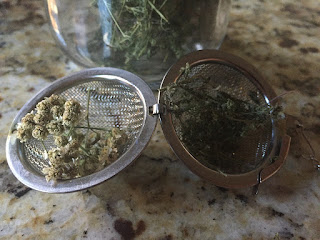Sassafras, Sassafras albidum, is a plant that I have walked passed for years and never sampled even though I knew it was edible. Today I was going to change that.
Sassafras is a tree that grows anywhere from ten to fifty feet. Its leaves consists of three different types-ovate (or egg-shaped), two lobed (like that of a mitten), and three lobed (like that of two-thumbed mitten). You can find examples of all of these on a single branch (Peterson, Lee, and Roger Tory Peterson). The bark develops furrows that deepen and whose ridges become flattened with age. The furrows are cinnamon-reddish at the base and turn reddish-brown with maturity. The ridges intersect to give the bark a woven appearance (Wojtech, Michael). It is a perennial meaning its life cycle lasts for more than two years and it is native to Canada and the lower 48 states. It is of special concern in the state of Maine where it is borderline endangered. There is no other legal status listed for the remaining states (Conservation Service, Natural Resources Resources).
Everything about the plant is aromatic. You can bruise the leaves, scratch the bark, and nap the roots and inhale it's lemony/chemically smelling aroma.
Sassafras is one of the main ingredients in the traditional root beer along with various herbs, roots and spices, filtered water, and cane sugar. According to Wiki the European settlers adopted the use of Sassafras tea from the Native Americans and turned it into the carbonated, sugar laden, foamy drink known as root beer.
Safrole-the plants main odor and flavor component-is listed on the FDA poisonous plant database. I have included their source regarding this claim below.
"Dihydrosafrole on chronic feeding produced benign and malignant esophageal tumors. Safrole is a hepatic carcinogen. Liver changes produced by isosafrole, safrole, and dihydrosafrole were of the same general type and included hepatic cell enlargement, which was usually focal and resulted in the formation of nodules; adenomatoid hyperplasia; cystic necrosis; fatty metamorphosis; and bile duct proliferation. The magnitude of liver changes was much greater with safrole than with the other two compounds. Safrole produced liver changes in mice. Similar treatment with the allylbenzene and methylenedioxybenzene moieties of safrole produced changes only with methylenedioxybenzene and were less than that observed with the parent compound. This was confirmed in rats by Taylor et al. (1964). All compounds studied produced liver alterations with the exception of allylbenzene and piperonal (FDA)."
Today safrole-free sassafras is used in root beer. Foster and Duke argue that the amount of ethanol in a can of beer is more carcinogenic than the amount of the safrole in traditional root beer (Foster, Steven, and James A. Duke)…what say the FDA to that? Further, scientists based their findings on the effects of laboratory animals from the isolated potent chemical administered in high doses. The whole plant was not used in these experiments so the effects on the isolated compound on laboratory animals is not necessary the same for people drinking the brewed tea from the whole plant (Derby, Blance Cybele. My Favorite Plants). The early European settlers used to drink this tea as a blood tonic (Foster, Steven, and James A. Duke).
I figured one glass would not have a great effect on me getting cancer and my curiosity got the best of me so I headed out onto the trail to find some Sassafras.
Further, the leaves can be dried and ground into file powder to thicken soups. The traditional spice of Louisiana and French-style dishes (Norman, Jill). Add the file powder to soups after the soup has been removed from heat, otherwise the soup becomes stringy (Derby, Blance Cybele. My Wild Friends)
Below I have included pictures to help you locate and prepare this wild edible for yourself.
 |
| Sassafras Bark-Notice How it Looks Woven |
 |
| Sassafras Bark-Damp with Rainwater |
 |
| Sassafras-Green Stem of Sapling |
 |
| Sassafras-Bright Green Stem |
 |
| Sassafras-Leaves Turning Yellow in Fall |
 |
| Roots being Boiled |
 |
| Boiled Sassafras Roots |
 |
| Sassafras Tea |
 |
| Fresh Leaves |
 |
| Dried Leaves |
 |
| Grinding Leaves with Mortar and Pestle |
 |
| Sifting Out Debris from Ground Leaves |
 |
| File Powder |
 |
| Broth-Pre-File Powder |
 |
| Broth After the Addition of File Powder |
Works cited
Conservation Service, Natural Resources Resources. "Welcome to the PLANTS Database | USDA PLANTS." Plants Database. USDA, 03 Oct. 2016. Web. 09 Oct. 2016. <http://www.plants.usda.gov/>.
Definitions
Derby, Blance Cybele. My Favorite Plants. Northhampton, MA: Wild Weed Woman, 2004. Print.
Derby, Blance Cybele. My Wild Friends: Free Food from Field and Forest. Northhampton, MA: Wild Weed Woman, 2001. Print.
FDA. "FDA Poisonous Plant Database." FDA Poisonous Plant Database. US Department of Health and Human Services, 12. Web. 12 Oct. 2016. <http://www.accessdata.fda.gov/scripts/Plantox/Detail.CFM?ID=11254>.
Foster, Steven, and James A. Duke. A Field Guide to Medicinal Plants and Herbs of Eastern and Central North America. Boston: Houghton Mifflin, 2000. Print.
Norman, Jill. Herbs & Spices. New York: DK, 2002. Print.
Peterson, Lee, and Roger Tory Peterson. A Field Guide to Edible Wild Plants of Eastern and Central North America. Boston: Houghton Mifflin, 1978. Print.
Wojtech, Michael. Bark: A Field Guide to Trees of the Northeast. Hanover: U of New England, 2011. Print.










